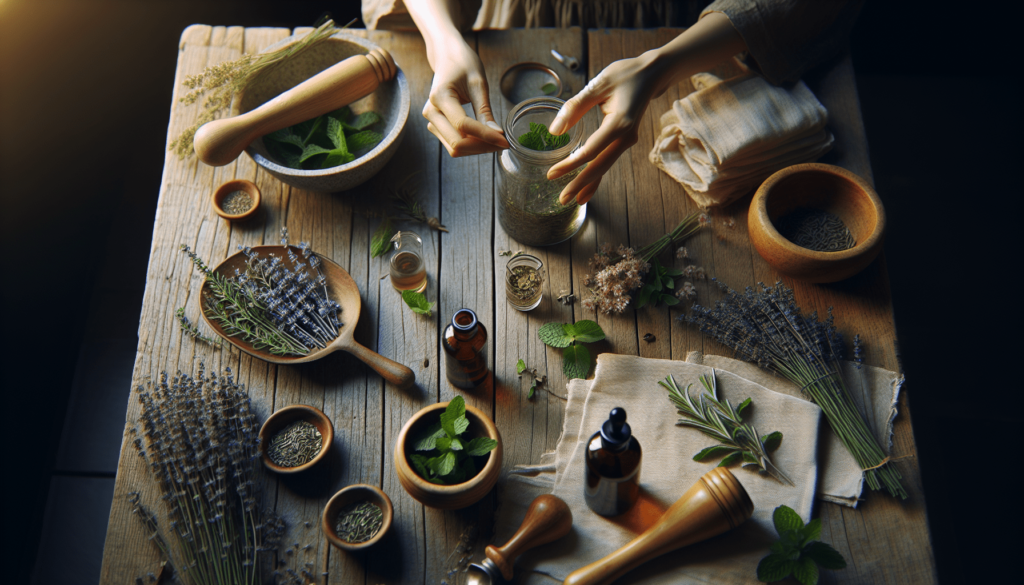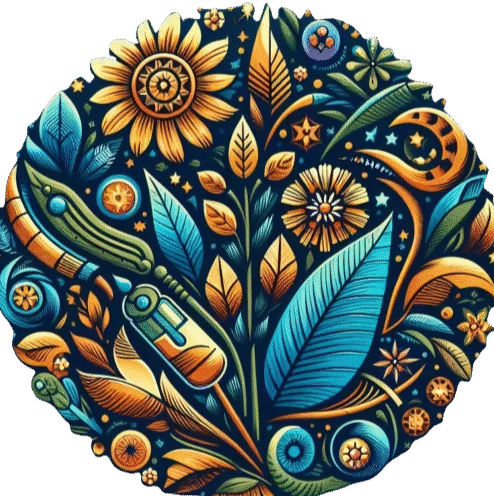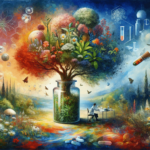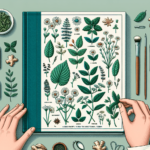So you’re interested in making your own herbal tinctures? Well, you’re in luck! In this article, we’ll guide you through the simple and fascinating process of creating your very own herbal tinctures. From selecting the right herbs to preparing the alcohol base, we’ll provide you with all the information you need to get started in the world of herbal medicine. Get ready to unleash your inner alchemist and discover the wonders of herbal tinctures. Let’s get started!
Choosing Herbs for Herbal Tinctures
When it comes to making herbal tinctures, the first step is to carefully choose the herbs you want to work with. The herbs you select will determine the properties and benefits of your tincture, so it’s important to do your research to ensure you’re using the right herbs for your needs.
Researching Different Herbs
Before diving into making herbal tinctures, take the time to research different herbs and their medicinal properties. Consider what you’re looking to achieve with your tincture, whether it’s for relaxation, immune support, or addressing a specific ailment. Look for herbs that are known for their desired effects and make a list of potential candidates.
Selecting High-Quality Herbs
Once you’ve narrowed down your list of herbs, it’s crucial to choose high-quality, organic herbs for your tinctures. Look for herbs that are ethically sourced and free from pesticides and other contaminants. Consider purchasing your herbs from reputable suppliers or, even better, grow your own if you have the space and resources.
Considering the Herb’s Properties
The properties of the herbs you choose will directly impact the effect of your tincture. Some herbs have a calming effect, while others are known for their stimulating properties. Consider the specific properties of each herb and how they align with your intended use for the tincture. This will help ensure you create a tincture that is effective for your desired purpose.
Gathering Supplies for Making Herbal Tinctures
Before diving into the tincture-making process, it’s essential to gather all the necessary supplies to ensure a smooth experience. Here are the supplies you’ll need:
Glass Jars or Bottles
Glass jars or bottles are a must-have for making herbal tinctures. The glass helps retain the potency of the tincture and prevents any unwanted reactions with plastic containers. Choose jars or bottles with tight-sealing lids to keep your tincture fresh and prevent any leakage.
Herbs for Extraction
Of course, you’ll need the herbs themselves for making the tincture. Make sure you have the specific herbs you researched and selected earlier. Whether you’re using fresh herbs or dried ones, make sure they are of high quality and free from any mold or mildew.
High-Proof Alcohol or Vinegar
Alcohol or vinegar acts as the solvent for the tincture. Use high-proof alcohol, such as vodka or Everclear, to extract the herb’s medicinal properties effectively. If you prefer a non-alcoholic tincture, you can substitute alcohol with apple cider vinegar or another high-quality vinegar.
Labels and Markers
To keep your tinctures organized and easily identifiable, it’s essential to have labels and markers on hand. Labeling each jar or bottle will help you remember the herb used and the date of preparation. Be sure to use waterproof markers or ink to prevent smudging or fading.
Measuring Tools
Accurate measurements are crucial when making herbal tinctures. Have measuring tools such as digital scales, measuring spoons, or graduated cylinders on hand to ensure precise measurements of the herbs and alcohol or vinegar.
Funnel
A funnel comes in handy when transferring the tincture into smaller bottles. Choose a funnel with a wide opening to prevent spills and make the bottling process more manageable.
Cheesecloth or Strainer
You’ll need a cheesecloth or a fine-mesh strainer to filter out the plant material from your tincture once it’s ready. This step ensures a smooth and pure tincture without any particles or debris.
Dark Storage Containers
To maintain the tincture’s potency, it’s crucial to store it in dark containers. Light can degrade the medicinal properties of the tincture over time, so opt for amber or dark glass bottles that provide UV protection.
Optional: Distilled Water or Glycerin
Depending on your preference and the specific herb you’re working with, you may choose to add distilled water or glycerin to your tincture. These ingredients can alter the tincture’s taste and consistency but may also enhance its properties. Experiment with small batches to find your preferred ratio.

Preparing the Herbs for Tincture Extraction
Before extracting the herbs in alcohol or vinegar, it’s important to prepare them properly. The preparation method can vary based on whether you’re using fresh or dried herbs, as well as whether you’re working with roots or barks.
Drying Fresh Herbs
If you’re working with fresh herbs, it’s crucial to dry them properly before using them for extraction. This helps remove excess moisture and prolongs the shelf life of your tincture. To dry fresh herbs, harvest them in the morning when the concentration of essential oils is highest. Tie them into small bundles and hang them upside down in a well-ventilated area away from direct sunlight. Once the herbs are completely dry, they are ready for the extraction process.
Crushing or Chopping Dried Herbs
For dried herbs, you’ll want to crush or chop them to increase the surface area and allow for better extraction. Use a mortar and pestle, herb grinder, or sharp knife to break down the dried herbs into smaller pieces. This step helps release the herb’s active compounds more efficiently.
Grinding or Powdering Roots and Barks
When working with roots or barks, you may need to take an additional step of grinding or powdering them. Roots and barks are often tougher and less easy to extract compared to leaves or flowers. Using a coffee grinder or a blender specifically designated for herbs, grind the roots or barks into a fine powder. This will allow for better extraction and ensures that the tincture captures the full range of medicinal properties.
Weighing or Measuring Herbs
To ensure accurate dosages and ratios, it’s important to weigh or measure the herbs before extraction. Use a digital scale or precise measuring spoons to determine the correct amount of herbs for your recipe. Different herbs may require different ratios, so refer to your recipe or adjust based on personal preferences and experience.
Extracting the Herbs in Alcohol or Vinegar
Once your herbs are prepared, it’s time to extract their medicinal properties by maceration, percolation, or a combination of both methods. The extraction process can take several weeks, so patience is key.
Choosing Alcohol or Vinegar Base
Choose whether you prefer to use alcohol or vinegar as your solvent. Alcohol is the most common choice due to its superior extraction properties and longer shelf life. However, if you prefer a non-alcoholic tincture or have specific dietary restrictions, vinegar can be a suitable alternative.
Maceration Method
The maceration method is a simple but effective way to extract the medicinal properties of herbs. Here’s how to do it:
- Fill the Glass Jar with Herbs: Place the prepared herbs into a clean glass jar, filling it about halfway. You can use a single herb or a combination of herbs based on your tincture recipe.
- Pour Alcohol or Vinegar Over the Herbs: Slowly pour your chosen solvent over the herbs until they are completely covered. Ensure that the alcohol or vinegar completely submerges the herbs to achieve the best extraction.
- Seal the Jar and Shake Daily: Securely seal the jar with its lid and gently shake it daily. This helps promote the extraction process by allowing the solvent to interact thoroughly with the herbs.
- Allow the Mixture to Steep for Several Weeks: Find a cool, dark place for your jar and let the mixture steep for at least four to six weeks. The longer you allow it to steep, the more potent your tincture will become.
- Strain and Bottle the Tincture: After the steeping period, strain the mixture using a cheesecloth or fine-mesh strainer, removing all the herb material. Funnel the resulting liquid into dark storage containers or smaller glass bottles, ensuring they are properly labeled.
The Percolation Method
The percolation method is another effective way to extract herbs, especially when dealing with tougher plant material. Here’s how you can use the percolation method:
- Prepare a Percolation Cone: Take a glass cone or funnel with a narrow stem, commonly available in laboratory supply stores. Make sure it fits securely on top of a glass jar or bottle.
- Layer the Herbs in the Cone: Place a layer of your prepared herbs at the bottom of the cone, ensuring it is evenly distributed.
- Pour Alcohol or Vinegar into the Cone: Slowly pour your chosen solvent into the cone until it fills up. The solvent will gradually flow down through the herbs, extracting their properties.
- Collect the Liquid as It Filters Through: Position a glass jar or bottle underneath the cone’s stem to collect the liquid as it filters through. This process may take time, so be patient and ensure a steady flow of solvent.
- Store and Bottle the Tincture: Once all the solvent has passed through the cone, collect the liquid in a dark storage container or smaller glass bottles. Be sure to label them properly and store them in a cool, dark place.
Combining Maceration and Percolation Methods
You can also choose to combine the maceration and percolation methods for a more comprehensive extraction. This method allows for greater efficiency and ensures a more potent tincture. Here’s how you can do it:
- Start with Maceration Method: Begin by following the maceration method outlined earlier, filling a glass jar with the prepared herbs and pouring your chosen solvent over them. Allow the mixture to steep for several weeks, shaking daily.
- Transfer the Macerated Mixture to the Percolation Cone: After the maceration period, strain the macerated mixture using a cheesecloth or strainer. Collect the resulting liquid and transfer it to a glass percolation cone, prepared with a layer of fresh herbs at the bottom.
- Continue with Percolation Method: Follow the percolation method as described earlier, pouring more solvent into the cone, allowing it to filter through the fresh layer of herbs, and collecting the liquid in a jar or bottle.
- Final Straining and Bottling: Once all the solvent has been filtered through the cone, strain the final liquid using a cheesecloth or fine-mesh strainer to remove any remaining plant material. Funnel the tincture into dark storage containers or smaller glass bottles and label them accordingly.

Labeling and Storing Herbal Tinctures
Properly labeling and storing your herbal tinctures is crucial for easy identification, safety, and maintaining their potency. Here’s what you need to know:
Labeling the Tincture Bottles
Label each tincture bottle with the name of the herb or herbs used, the type of solvent (alcohol or vinegar), and the preparation date. This information will ensure that you know what the tincture is for and when it was made. You may also include any additional notes, such as specific dosage instructions or special considerations.
Including Relevant Information on Labels
Besides the essential details mentioned above, you may consider including additional information on the labels. This could include the plant part used (leaves, flowers, roots), the botanical name, any contraindications or precautions, and your own personal recipe or dosage recommendations. The more information you provide, the better you can tailor the tincture to your specific needs.
Choosing Proper Storage Containers
To maintain the potency of your tinctures, store them in dark glass containers, preferably amber or cobalt blue. These containers offer protection against light, which can degrade the tincture’s medicinal properties. Make sure the containers have tight-sealing lids to prevent air exposure and leakage.
Storing Tinctures in a Cool and Dark Place
When it comes to storing herbal tinctures, a cool and dark place is ideal. Excessive heat and sunlight can accelerate the tincture’s degradation, so choose a cupboard or cabinet away from direct light sources or heat-emitting appliances. Avoid storing tinctures near the stove, oven, or windows.
Shelf Life and Expiration Dates
Herbal tinctures can have a long shelf life if stored properly. Alcohol-based tinctures can last for several years, while vinegar-based tinctures have a slightly shorter shelf life. However, it’s essential to periodically check your tinctures for any signs of spoilage, such as mold or changes in color or odor. Whenever in doubt, it’s better to err on the side of caution and discard any tinctures that appear compromised.
Using Herbal Tinctures
Once you’ve successfully prepared your herbal tinctures, it’s time to utilize them for various purposes. Here’s what you need to know about using herbal tinctures effectively and safely.
Determining the Correct Dosage
Dosage is a critical factor when using herbal tinctures. Each herb has different recommended dosages, so it’s important to do your research or consult a healthcare professional. Start with the lowest recommended dose and gradually increase if necessary, paying attention to any adverse reactions or side effects.
Diluting Tinctures for Consumption
While some herbal tinctures can be taken directly, others may need to be diluted before consumption. Follow the instructions provided with the specific tincture or consult a knowledgeable herbalist or healthcare professional. Water or juice are commonly used as diluents, but you can also explore other options based on personal preferences.
Administering Tinctures Orally
Herbal tinctures are typically taken orally for maximum absorption and effectiveness. Measure the correct dosage, dilute if necessary, and consume the tincture orally, either by using a dropper or by mixing it with a small amount of water or juice. Hold the tincture in your mouth for a few seconds before swallowing to allow for sublingual absorption.
Considering Other Administration Methods
While oral administration is the most common method of using herbal tinctures, you can explore other creative ways depending on your preferences and needs. Some tinctures can be added to bathwater for topical absorption, while others can be used as a spray or gargle. Always ensure that the administration method is appropriate for the specific herb and consult a healthcare professional when in doubt.
Consulting a Healthcare Professional
It’s important to note that while herbal tinctures have been used for centuries, they are not a substitute for professional medical advice. If you have any underlying health conditions, are taking medications, or are pregnant or breastfeeding, consult with a qualified healthcare professional before incorporating herbal tinctures into your routine. They will ensure that the tinctures are safe and appropriate for your specific situation.
Exploring Different Herbal Tincture Recipes
Now that you’re familiar with the process of making herbal tinctures and how to use them, it’s time to explore various recipes and concoctions. Here are a few ideas to get you started:
Single Herb Tincture
A single herb tincture is a great way to experience the specific benefits of a particular herb. Choose an herb that aligns with your health goals or addresses a specific concern. Research the recommended dosage and follow the extraction methods outlined earlier. This simple yet effective tincture can be a powerful addition to your natural medicine cabinet.
Combination Tincture
Combining multiple herbs in a tincture allows you to create a blend that targets specific needs or conditions. For example, a blend of calming herbs like chamomile, lavender, and lemon balm can create a soothing and relaxing tincture. Experiment with different combinations to find the perfect blend that works for you.
Specific Condition Tincture
If you’re dealing with a specific condition or ailment, consider creating a tincture tailored to address those concerns. Research herbs that are known to alleviate symptoms or support the body’s natural healing mechanisms related to your condition. Consult with an herbalist or healthcare professional to ensure you select the appropriate herbs and dosages.
Adapting and Experimenting with Recipes
Don’t be afraid to adapt and experiment with tincture recipes to suit your personal preferences and needs. You can vary the ratios of herbs or adjust the extraction methods to achieve different potency levels or tastes. Keep track of your recipes and dosage recommendations to refer back to for future reference.
By following these steps and guidelines, you can confidently explore the world of herbal tinctures, creating blends that support your health and well-being. Remember to prioritize quality, research, and responsible use of these natural remedies, and consult with professionals whenever necessary. Happy tincture-making!





